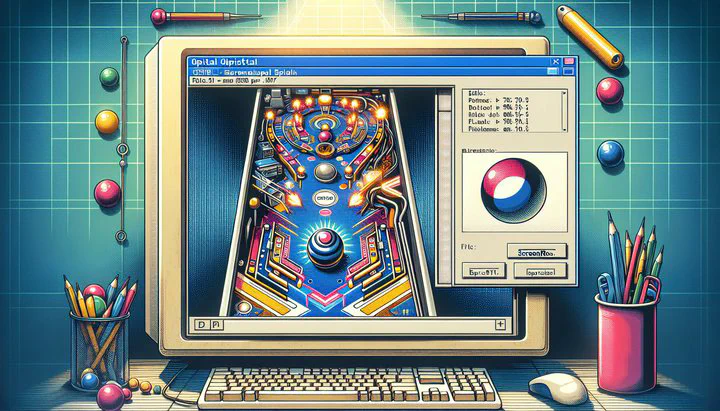How to Use Screenres.txt File for VP 9.95 Playfield

Mastering the Screenres.txt File for VP 9.95 Playfield Setup
Welcome to the world of virtual pinball, where the thrill of classic gaming meets modern technology. If you’ve just started exploring VP 9.95, there’s one tool you need to know about: the screenres.txt file. This handy file is like your backstage pass to perfect pinball visuals. It controls how the playfields, back glass, and DMD (Dot Matrix Display) appear on your screens. Let’s dive in and see why this file is essential for your gaming setup.
Why the Screenres.txt File is Your Best Friend
Think of the screenres.txt file as a guide for your monitors. It tells them exactly how to display the playfields and other components of your virtual pinball machine. Whether you’re using a single screen or multiple monitors, including one connected to your PC in portrait mode, this file makes sure everything appears where it should. Without it, you might find yourself frustrated with out-of-order displays or missing elements.
This file is crucial because it allows for customization. By adjusting settings in the screenres.txt file, you can tell what monitor to display the playfield on, ensuring everything fits perfectly. This is especially important if you’re using multiple monitors or if one is in portrait mode. Proper configuration prevents common issues like missing a lot of decals and colors looking terrible, ensuring your playfield is as vibrant and complete as it should be.
As you embark on your VP 9.95 journey, remember that the screenres.txt file is your ticket to an optimized visual setup. It helps you achieve that authentic pinball feel, making your retro gaming experience even more enjoyable. Get ready to dig into this file and unlock the full potential of your virtual pinball adventures!
Configuring Multiple Monitors: A Step-by-Step Guide
Setting up multiple monitors for your virtual pinball machine can transform your gaming experience, giving you a more immersive feel. To do this right, you need to master the screenres.txt file for VP 9.95 playfield. This file is your tool to configure where each element of your pinball game appears, especially when you have more than one screen connected to your PC, with one being in portrait mode.
First, open your screenres.txt file. This file is like a map that tells what monitor to display the playfield on. Each line in the file corresponds to details about your monitors, like resolution and position. For example, you might have one monitor for the playfield, another for the back glass, and a third for the DMD. Make sure each monitor’s resolution matches what’s in the file, so everything displays correctly.
When you have a monitor in portrait mode, you’ll need to pay special attention. Adjust the settings in the screenres.txt file to ensure the playfield shows up just right. You can change the orientation and position so that everything fits perfectly. This might take some trial and error, but don’t worry—small tweaks can make a big difference.
If you run into trouble, like parts of the game not showing up or looking strange, check your screenres.txt file settings again. Common issues come from tiny errors in the file, like a wrong resolution or a mismatch in monitor positioning. By carefully editing these details, you can solve problems and ensure your virtual pinball setup is smooth and visually stunning. Remember, getting your monitors set up is key to enjoying the full virtual pinball experience!
Troubleshooting Display Issues: Quick Fixes
Sometimes, even after setting up your monitors, your virtual pinball game doesn’t look quite right. Maybe you’re missing a lot of decals and colors look terrible. Don’t worry—your screenres.txt file for VP 9.95 playfield can help you fix it!
First, let’s tackle the problem of missing decals. This usually happens when the screenres.txt file isn’t configured correctly. Check to make sure the resolution settings in the file match your monitors’ actual resolutions. A small mistake here can lead to big display problems.
Next, if the colors in your game look off, it might be due to incorrect color depth settings. In the screenres.txt file, adjust the color settings to align with what your monitors can handle. Sometimes, tweaking these settings can bring your game back to life with vibrant colors and crisp graphics.
If you’re still having trouble, try experimenting with different settings in the screenres.txt file for the back glass and the DMD. Sometimes, adjusting these settings can indirectly fix issues with the playfield display. Remember, each monitor setup is unique, so what works for one person might not work for another. Be patient and make small adjustments until you find the perfect configuration.
By carefully editing the screenres.txt file, you can solve these common display issues and enjoy a beautifully set-up virtual pinball experience. With everything looking just right, you can focus on what really matters—having fun and reliving those classic gaming moments!
Final Tips
- Engage with our community! Share your setup or any tips you have in the comments. We love hearing from fellow retro gaming enthusiasts.
- If you have questions or run into any issues, feel free to ask. We’re here to help you enjoy the best virtual pinball experience possible!